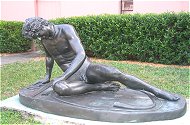Dying GaulChiurazzi description: |
Description:
Copy of the bronze statue dedicated at Pergamon by Attalos I (Turkey) to commemorate his
victory over the Gauls (239 BCE). It was set on the Acropolis to celebrate victory of
Attalus over the Gauls.
The statue depicts a dying Celt with remarkable realism, particularly in the face. He is represented as a Gallic warrior with a typically Gallic hairstyle and moustache. The figure is naked save for a neck torc. The statue serves both as a reminder of the Celts' defeat, thus demonstrating the might of the people that defeated them, and a memorial to their bravery as worthy adversaries. It also provides evidence to corroborate ancient accounts of the Gallic fighting style; Julius Caesar records in his account of the Gallic War that the Gauls went into battle naked save for their weapons.
Subject info:
The marble sculpture is first recorded in the Ludovisi
collection in Rome in 1623. It was probably discovered shortly before that when the villa
was being built. Sometime before 1737 it was acquired by Pope Clement XII for the
Capitoline Museum. It went to Paris for some 15 years in 1800, but then returned to Rome.
The sculpture received some extra buzz because of the involvement of Michelangelo, who restored the missing right arm.
The first 200 years the name for the sculpture was "Gladiator", although all experts agreed that it was very unlikely that a sculpture would have been made for such a low subject. It was however known that heralds in the Olympic games wore ropes around their necks to prevent the strain on their voices leading to burst blood vessels (there is a rope around the person's neck). However, the physical characteristics of the figure seem to prove that he was a barbarian, either a Gaul or a German, who had presumably died on the battle field. On one occasion had the Gauls made any real impact on the Greeks. This was in the beginning on the 3rd century BCE when they attacked Delphi. Since the late 19th century the figure has in fact been considered by many scholars to be a copy of one of the bronzes dedicated by Attalus I in the first half on the 3rd century BCE, after victories over the Gauls. The statue is catalogued by Helbig as a copy of the bronze which, together with Paetus and Arria, was made for Attalus of Pergamon (241 - 197 BCE) to adorn a monument recording his victories over the Gauls.
Another entry:
The Dying Gaul or Dying Trumpeter is an ancient Roman marble copy of a lost ancient Greek
statue, thought to have been executed in bronze, that was commissioned some time between
230 BC and 220 BC by Attalos I of Pergamon to honor his victory over the Galatians. The
present base was added after its rediscovery. The identity of the statue's sculptor is
unknown but it has been suggested that Epigonus, the court sculptor of the Attalid dynasty
of Pergamon, may have been its author.
The Dying Gaul became one of the most celebrated works to have survived from antiquity and
was endlessly copied and engraved by artists and sculptors. It is thought to have been
rediscovered in the early 17th century during excavations for the foundations of the Villa
Ludovisi and was first recorded in 1623 in the collections of the powerful Ludovisi family
of Rome.
The artistic quality and expressive pathos of the statue aroused great admiration among
the educated classes in the 17th and 18th centuries. It was widely copied, with kings,
academics and wealthy landowners commissioning their own reproductions of the Dying Gaul.
The less well-off could purchase copies of the statue in miniature for use as ornaments
and paperweights.
During this period, some misinterpreted the statue's theme as representing a defeated
gladiator, leading to the coining of several (entirely erroneous) alternative names for
the statue: the 'Dying' or 'Wounded Gladiator', 'Roman Gladiator', and 'Myrmillo Dying'.
It was looted by Napoleon Bonaparte in 1797 during his invasion of Italy and taken to
Paris, where it was put on display. It was returned to Rome in 1815 and is currently on
display in the Capitoline Museums.
